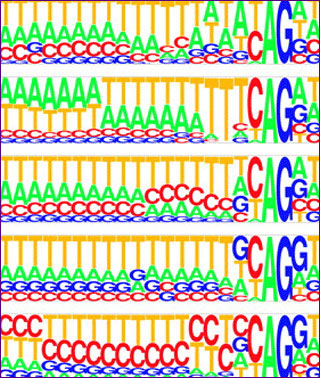
Splice signal motifs of five species, created using the PICTOGRAM program. The height of each letter is proportional to the frequency of the corresponding base at the given position, and bases are listed in descending order of frequency from top to bottom. Source: Figure 2 of Lim, Lee P., and Christopher B. Burge. "A Computational Analysis of Sequence Features Involved in Recognition of Short Introns." Proceedings of the National Academy of Sciences 98, no. 20 (2001): 11193–8. (Courtesy of National Academy of Sciences)
Instructor(s)
Prof. Christopher Burge
Prof. David Gifford
Prof. Ernest Fraenkel
MIT Course Number
7.91J / 20.490J / 20.390J / 7.36J / 6.802J / 6.874J / HST.506J
As Taught In
Spring 2014
Level
Undergraduate / Graduate
Course Description
Course Features
- Video lectures
- Captions/transcript
- Lecture notes
- Projects (no examples)
- Assignments: presentations (no examples)
- Assignments: programming with examples
- Assignments: written (no examples)
Course Highlights
The MIT Initiative in Computational and Systems Biology (CSBi) is a campus-wide research and education program that links biology, engineering, and computer science in a multidisciplinary approach to the systematic analysis and modeling of complex biological phenomena. This course is one of a series of core subjects offered through the CSB Ph.D program, for students with an interest in interdisciplinary training and research in the area of computational and systems biology.
Course Description
This course is an introduction to computational biology emphasizing the fundamentals of nucleic acid and protein sequence and structural analysis; it also includes an introduction to the analysis of complex biological systems. Topics covered in the course include principles and methods used for sequence alignment, motif finding, structural modeling, structure prediction and network modeling, as well as currently emerging research areas.
Other Versions
Other OCW Versions
Archived versions: ![]()


